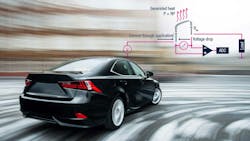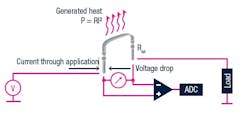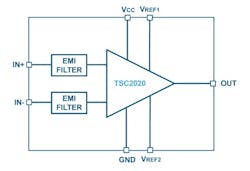Auto-Qualified Current-Sense Amp Features Low Offset and Drift, High CMR
Using a resistor and voltage amplifier across it for current sensing presents a conundrum. On one hand, it appears to be near-trivial application of Ohm’s Law via I = V/R. It certainly looks easy: A tiny resistance is placed on the current path and the linear voltage drop is amplified to derive a precise current measurement (Fig. 1).
On the other hand, sizing the value and power dissipation of the sense resistor and choosing a suitable current-sense amplifier (CSA) brings many tradeoffs and challenges. It’s even more daunting if the resistor is inserted on the non-grounded high side, which is usually preferred over low-side (ground side) sensing for a variety of operational reasons.
That CSA must not only offer high gain along with low offset voltage and offset drift, but it must also endure high common-mode voltage (CMV) in many installations, provide high common-mode rejection (CMR), and include EMI/RFI immunity in many design situations.
AEC-Q100-Qualified Bidirectional Current-Sense Amplifier
A new CSA solution comes by way of STMicroelectronics with its TSC2020 bidirectional current-sense amplifier for applications such as servers, power tools, industrial motor control, and power supplies (Fig. 2). It’s also AEC-Q100 qualified for use in automotive functions such as motor-controlled window lifters (power windows), battery-management systems (BMS), and traction inverters.
This current-sense amplifier assures high accuracy and saves space by eliminating external components typically needed for protection and gain-setting configuration. It’s suitable for both high- and low-side current sensing, with a wide common-mode voltage range from −4 to 100 V, making it a fit for increasingly popular 48-V systems and higher voltages. The precision internal circuitry ensures input offset voltage within ±150 µV to help greatly reduce the external shunt resistor size and thus lower power dissipation rating of the sense resistor.
The TSC2020 can sense very low voltage drops, which helps minimize measurement errors. Common-mode rejection of at least 100 dB ensures consistent accuracy when exposed to fluctuating common-mode voltages in applications such as inline motor control. Also, enhanced pulse-width-modulation (PWM) rejection delivers high immunity to noise in motor drives and switched-mode power converters.
The TSC2020’s fixed gain of 20 V/V ensures high accuracy and stability, featuring 0.3% gain error and 3.5 ppm/°C gain drift; no trimming is required. Further, the integration reduces the number of external components needed, simplifying the bill of materials (BOM).
The current-sense amplifier is supported by a 26-page datasheet with approximately 50 graphs characterizing performance for many static and dynamic conditions. It operates from a 2.7- to 5.5-V supply over the industrial temperature range of −40 to 125°C. It’s in mass production now, offered in SO-8 and mini SO-8 packages. Pricing starts at $1.20 each for orders of 1,000 units.
Reference
STMicroelectronics, “Current Sensing Reference Guide.”
About the Author

Bill Schweber
Contributing Editor
Bill Schweber is an electronics engineer who has written three textbooks on electronic communications systems, as well as hundreds of technical articles, opinion columns, and product features. In past roles, he worked as a technical website manager for multiple topic-specific sites for EE Times, as well as both the Executive Editor and Analog Editor at EDN.
At Analog Devices Inc., Bill was in marketing communications (public relations). As a result, he has been on both sides of the technical PR function, presenting company products, stories, and messages to the media and also as the recipient of these.
Prior to the MarCom role at Analog, Bill was associate editor of their respected technical journal and worked in their product marketing and applications engineering groups. Before those roles, he was at Instron Corp., doing hands-on analog- and power-circuit design and systems integration for materials-testing machine controls.
Bill has an MSEE (Univ. of Mass) and BSEE (Columbia Univ.), is a Registered Professional Engineer, and holds an Advanced Class amateur radio license. He has also planned, written, and presented online courses on a variety of engineering topics, including MOSFET basics, ADC selection, and driving LEDs.


